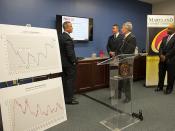Unemployment is very closely related to the business cycle. As well as experiencing fluctuations in unemployment, most countries have experienced an increase in average unemployment rates from one cycle to another. Unemployment occurs when people are actively looking for jobs but can't find one. The most common definition of unemployed people is those of working ages who are without work, but who are available for work at current wage rates.
Measurement of unemployment:
Unemployment is measured by the following formula:
Unemployment rate = unemployed/ labor force * 100
Before applying this formula its important to understand what is meant by the terms employed, unemployed and the labor force.
A person is employed if he or she spent most of the previous week working at a job--as opposed to keeping house, going to school, doing something else, et cetera.
A person is unemployed if they wanted to work during that previous week, but did not--because they were temporarily laid off, because they have been hired but their new job has not yet started, or because they were looking for work but did not find any.
The employed and the unemployed both make up the labor force. The people who are not included in the labor force are:
*Children under 16
*Retirees
*Home-makers
*Mentally ill or retarded persons
*Full time students
*And even, idle people who simply do not want to work.
Types of Unemployment:
Unemployment can occur for different reasons. It can be categorized into four types:
frictional, seasonal, structural and cyclical unemployment.
*Frictional Unemployment:
Frictional unemployment broadly consists of two types of unemployment:
Search unemployment i.e. workers who are searching for better jobs. At any given time some workers are between jobs. Some of them will be moving voluntarily from one job to another.
Wait unemployment i.e. workers waiting to...



No works cited!
The author has used passive voice throughout (including "there will", "there is", etc.)
The paper also has no works cited, though most of this must have come from a source SOMEWHERE.
7 out of 7 people found this comment useful.